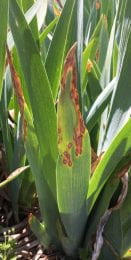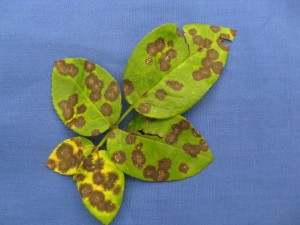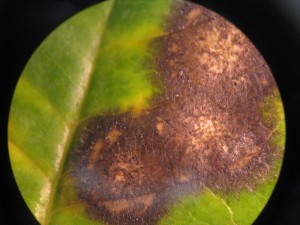By Judy O’Mara
I was out working in the garden last weekend and I saw the first appearance of iris leaf spot (Didymellina macrospora). This is a very unattractive fungal disease. The iris planting puts out nice looking flowers each year but for the rest of the season everything looks rough, with heavy leaf spotting and leaf scorch. Iris leaf spot will show up in most years but will be severe in years that are wet.
 Iris leaf spot is not an easy disease to clean up because it overwinters in the residue. So the first step for management is to clean up the flower bed in the fall after frost has killed the tops. This will help to reduce the amount of disease that is carried over. Unfortunately it won’t get rid of the disease. If the planting is old and crowded, digging them up and respacing them will improve air flow. This can help to reduce disease severity.
Iris leaf spot is not an easy disease to clean up because it overwinters in the residue. So the first step for management is to clean up the flower bed in the fall after frost has killed the tops. This will help to reduce the amount of disease that is carried over. Unfortunately it won’t get rid of the disease. If the planting is old and crowded, digging them up and respacing them will improve air flow. This can help to reduce disease severity.
Start fungicide protection (chlorothalonil or mycloblutanil) when leaf spotting first shows up early in the spring. Four to six applications may be needed at 7-10 day intervals. Adding a spreader sticker will help coverage and effectiveness of the treatment.
For more information on iris leaf spot check out the following K-State Horticulture fact sheet. https://hnr.k-state.edu/extension/info-center/common-pest-problems/common-pest-problem-new/Iris%20Leaf%20Spot.pdf



